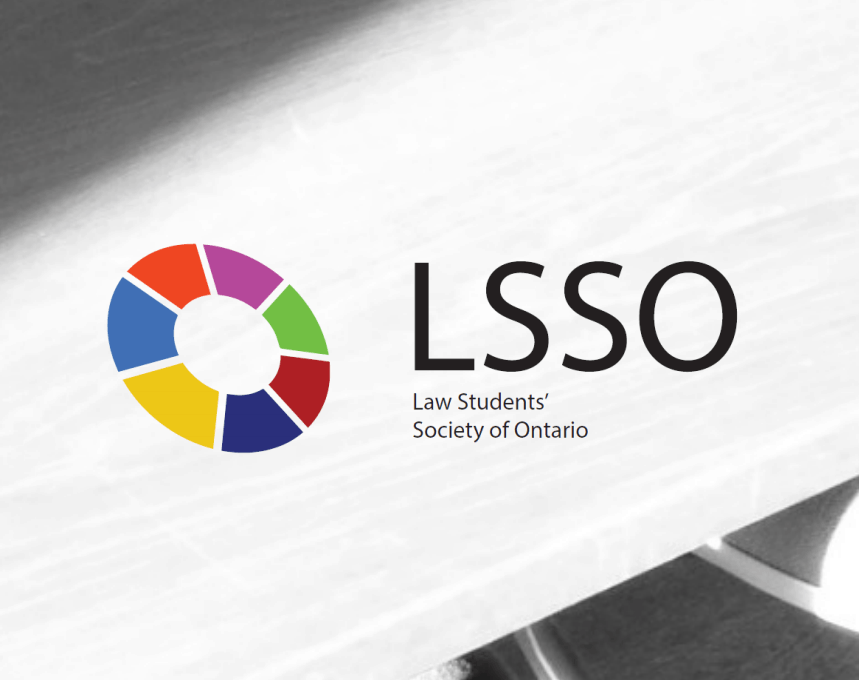Brett Hughes (2L)
On Saturday March 14, law student leaders from across the province gathered at Osgoode Hall Law School for the Law Students’ Society of Ontario’s (LSSO) second annual general meeting. The LSSO is an advocacy organisation representing all seven of Ontario’s common law faculties. Its purpose is “to advance student concerns to governmental, regulatory, and educational stakeholders on issues such as access to legal education, professional accreditation requirements, and other matters affecting law students across the province.”
The agenda included a recap on the LSSO’s activities in 2014-15 from outgoing President Douglas Judson, elections for the 2015-16 executive, a presentation on the Canadian Bar Association’s (CBA) “Legal Futures Initiative,” and a priority setting session for the upcoming year.
Judson began by providing a summary of some of the LSSO’s efforts in its inaugural year, which were focused on the priority areas of: raising awareness about consequences of tuition costs, monitoring the implementation of the Law Practice Program (LPP), lobbying for changes to the Law Society of Upper Canada’s (LSUC) 74% licensing fee increase, and advocating for inclusive, representative law schools.
The year began with the September release of the LSSO report on its 2014 Survey of Ontario Law Students’ Tuition, Debt, and Financial Aid Experiences. The first-of-its-kind survey obtained data from 941 students across the province on the connections between tuition, debt and career choices, mental health, and diversity.
In December, the LSSO made a submission to LSUC on alternative business structures, advocating for the adoption of “a liberal approach to the rules on permitted law firm business structures.” The LSSO argued that there is both a strong access to justice case and business case for such liberalisation.
In January, the LSSO wrote to LSUC Treasurer Janet Minor to express concerns about the Law Practice Program (LPP). The letter requested that LSUC impose a compensation requirement on LPP employers, highlighting the fact that 40% of the available Ryerson LPP work placements were unpaid. It focused on the “tremendous power imbalance” created, general concerns flowing from a two-tier licensing system, and equity concerns related to demographics of students most likely to rely on the LPP.
The morning concluded with elections for the new LSSO executive. All positions were acclaimed, except for Vice President Internal. The new executive is comprised of: Ryan Robski, President (Osgoode); Shreya Tekriwal, Vice President Internal (Windsor); Adam Gilani, Vice President External (Ottawa); and Leslie De Meulles, Equity Officer (Lakehead).
Over lunch, the Project Director of the CBA’s Legal Futures Initiative, Karin Galldin, presented on the initiative, which aims to address the “wave of fundamental change” facing Canada’s legal sector, driven by globalisation, technology, economics, demographics, and more. Its purpose is to: (1) provide leadership and a systemic response to transformative change; (2) canvass and reflect views from “within and outside” the legal community; and (3) provide a framework for “ideas, approaches, and tools” to help the profession adapt to change.
One of the main challenges in responding to or leading, change in the legal sector is a lack of data. As Galldin put it, “we know nothing about what law graduates do in Canada.” She suggested that law schools should collect and publish more detailed information. The American Bar Association, for example, imposes extensive data collection and disclosure requirements on American law schools.
Galldin also spoke about prompting a culture change with respect to who is “allowed” into the conversation about the future of legal services in Canada. She said that client voices tend to be disregarded, and she referred to Professor Julie Macfarlane’s work on the challenges faced by self-represented litigants.
Finally, the afternoon portion focused on planning for the upcoming year.
There was an extended discussion on the LSSO’s funding structure. The organisation operated on a total budget of $500 for 2014-15 through direct payments from constituent law societies. The outgoing executive raised the idea of pursuing a $0.50 per student levy to increase funding—there are approximately 4,000 JD students in Ontario, thus making for approximately $2,000 in annual funding. All student representatives agreed with calculating funding on a per student basis, but differed on whether a direct levy was a feasible or appropriate mechanism, and whether the fee should be increased at this stage.
Additionally, attendees focused on LSUC’s decision to stop offering hard copy bar exam materials as part of the bar exam materials fee. LSUC removed the hard copy without changing the price; only a PDF is available now. Given that the material changes little from year to year, and is now only available online, it is unclear why students are expected to pay the same amount, let alone anything at all. The LSSO looked set to issue a statement criticising the change and advocating for alternatives, such as returning to the old approach, or offering free or cheap PDFs, while offering optional paid printed material.
Lastly, there was a discussion about how to approach the bencher elections. The elections only happen every four years, making this a unique opportunity to press candidates on issues affecting law students and young lawyers. As Precedent magazine pointed out, only two current benchers are under the age of 50. The LSSO discussed sending a questionnaire to all candidates, with a view to sparking conversation on issues such as having students exclusively bear the cost of increased licensing fees, and more.






